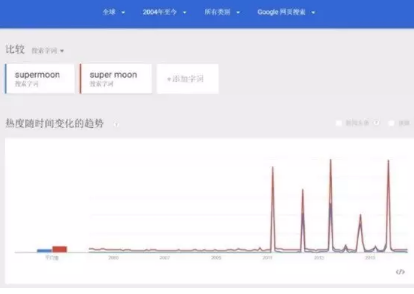关于周一出现的“超级月亮”,各位一定都被各种能看清、或看不清的赏月图刷屏了吧。昨天,阿盟为大家准备的文章其实相对“消极”,是为了让大家不要对“超级月亮”太过期待,避免失望。
“超级月亮”这个概念是如何构建的,许多人还是知之甚少。没关系,阿盟这就为大家分享一篇文章,让我们了解“超级月亮”的前世今生。
自“超级月亮”这个概念诞生之日起,其内涵虽有变化,但绝非含糊不清,模棱两可。
“超级月亮”:现代星占的亲儿子
“超级月亮”这一概念最早由美国占星师 Richard Nolle 于1979年提出,在 Nolle 的个人网站上,可以看到他的一段关于“超级月亮”的叙述:
SuperMoon is a word I coined in a 1979 article for Dell Publishing Company‘s HOROSCOPE magazine, describing a new or full moon which occurs with the Moon at or near (within 90% of) its closest approach to Earth in a given orbit。 In short, Earth, Moon and Sun are all in a line, with Moon in its nearest approach to Earth。 At any new or full moon, Earth and Moon and Sun are all in a line: Earth is in the middle in the full moon alignment, while the new moon happens with Moon in the middle。 This coming together in an alignment is technically termed a syzygy。 Sometimes - from a few times to a half-dozen times in a given year - these alignments also happen when the Moon is in its perigee, or closest approach to Earth。 Astronomers call this very special alignment a perigee-syzygy。 I call it a SuperMoon – which is a whole lot easier on the tongue。 (My most recent print article on this subject appeared in the October-November 2007 issue of The Mountain Astrologer。)
一定有人说“太长,不看!”其实我也觉得长。。。。。。 Nolle 在2007年也发表过一个简明版的定义:
[etymology: coined by author Richard Nolle, in Dell Horoscope, September 1979。] A lunar perigee-syzygy, a New or Full Moon (syzygy) occurring when the Moon is at or near (within 90% of) its closest approach to Earth (perigee)。
个人感觉,这段话并不能很好地直译为中文,简单来说,就是地月距离小于一定条件值的满月或者新月,都是“超级月亮”。至于这个条件值是多少,如果以地月平均距离为基准,就是368630km。也就是说,地月距离小于368630km的新月或者满月,在 Nolle 看来就算“超级月亮”。
这位占星师必然不会是吃饱了没事干,创造这么一个概念。说他是占星师,这个概念是要为占星术服务的。Nolle 就认为,“超级月亮”和地震、火山喷发、海啸等极端自然事件有着某种联系:
By definition at least, it should be clear now what a SuperMoon is。 But what does it mean? What’s it good for? For starters, it’s a strong signal of geophysical disturbances – tidal surges in Earth’s atmosphere, oceans, and crust that correspond to severe storms, unusually high tides, and moderate to severe seismic activity, including volcanic eruptions as well as Richter Magnitude 5+ earthquakes。 That’s enough to make the SuperMoon a matter of particular interest in the field of mundane astrology。
天文学界:“超级月亮”的干爹
时间来到2011年。是年3月11日,日本发生了震惊世界的9.0级大地震,并引发海啸,而此后不久的3月19日月相为望,月球也正好运行到近地点,出现 Nolle 定义的“超级月亮”。日本的大地震似乎可以成为确证 Nolle 理论的一个有力证据。
反对的声音很快出现,甚至在大地震发生以前就已存在。在3月11日以前至少有三篇针对 Nolle 预言“超级月亮”引发灾难的反驳文章,3月9日英国《每日邮报》与著名天文科普网站space.com先后发文,两者都提到即将在3月19日到来的“超级月亮”,但对于“超级月亮”引发极端自然事件的说法都予以否认。其中《每日邮报》援引国际射电天文中心的Pete Wheeler,提到“(3月19日)不会出现地震或火山爆发,除非本来就要发生”,直接否定了出现“超级月亮”与发生极端自然事件的因果关系。而space.com则援引诸位地震方面的专家,提到目前尚未发现“超级月亮”与地震间的直接联系。另一家天文科普网站Universe Today则在次日(3月10日)发文驳斥预言。
3月11日发生的日本大地震使得被打压多日的预言再度抬头,而驳斥的声音也没有停息。地震当日,NASA戈达德航空航天中心首席科学家James Garvin针对“超级月亮”作出回复,回答了几个民众关心的问题。
同一天著名天文科普人Phil Plait在其Bad Astronomy博客上发表长文,题为《不,日本地震并非“超级月亮”所致》(No, the “supermoon” didn‘t cause the Japanese earthquake),一周后又发表另一篇文章《“超级月亮”的“克星”》(Kryptonite for the supermoon),对Nolle提出的“超级月亮”概念本身进行抨击。于此同时国内著名科普社区果壳网旗下的“谣言粉碎机”栏目也于3月14日发表题为《月球“近地点”将引发超级强震?》的文章。
天文爱好者应该都很熟悉NASA旗下的每日天文一图(APOD)。当年3月20日,也就是所谓“超级月亮”之夜的第二天,APOD发布了一张满月和帕特农神庙的合影,并在文字描述中提到了前一晚上的月亮:
But the full moon really was a large Full Moon last night, reaching its exact full phase within an hour of lunar perigee, the point in the Moon‘s elliptical orbit closest to planet Earth。
APOD并没有使用“超级月亮”的称谓,而是“A near perigee full moon”,即接近近地点的满月。

作者:Anthony Ayiomamitis 来源:APOD: 2011 March 20
不过,从2012年开始,天文学界就悄悄地将“超级月亮”这个概念“据为己有”,毕竟“Super Moon”比“A near perigee full moon”,“perigee-syzygy”什么的要朗朗上口许多,推广起来可谓毫不费力。
2012年5月7日,APOD发布了《巴黎的“超级月亮”》(Supermoon Over Paris)。

这是我目前找到的天文学界第一次正式使用“超级月亮”概念的记录。2013年,David Dickinson在Universe Today发表了《“超级月亮”是什么?》(WHAT IS A SUPER MOON?),文中给出了“超级月亮”的明确定义:
A supermoon is defined here as a Full Moon occurring within 24 hours of perigee。
这是一个有别于 Nolle 的“超级月亮”定义,也是天文学界第一次出现明确的“超级月亮”定义。
按照David Dickinson的定义,每年将会有连续两到三次的“超级月亮”。今年NASA就参考了这样一个定义(2013、2014年也有类似的宣传):
This is actually the second of three supermoons in a row, so if the clouds don’t cooperate for you this weekend, you will have another chance next month to see the last supermoon of 2016 on Dec。 14。
昨晚的“超级月亮”将是三次连续“超级月亮”的第二回,所以即便这个周末(美帝时间周日)天公不作美,下个月14号还有一次机会观测本年度最后一次“超级月亮”。
我们利用Google Trends来回顾一下近年来“超级月亮”的搜索热度:13

如果说2011年的热度是日本地震带起来的,那之后一年一度的高峰又如何解释?我敢说当中有大半的功劳是以NASA为首的美帝天文科普界的推波助澜。老大哥发话,各路媒体自然跟风转。
所以说,营销“超级月亮”概念的万恶之源,其实是咱们科普界的老大哥NASA呀。